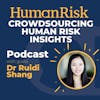Dr Ruidi Shang on Crowdsourcing Human Risk Insights

How can we use crowdsourcing to obtain human risk insights?
We’re all familiar with companies that have faced big issues in terms of misconduct. When there’s a big scandal — whether that’s banks engaging in bad behaviour or the diesel emissions...
How can we use crowdsourcing to obtain human risk insights?
We’re all familiar with companies that have faced big issues in terms of misconduct. When there’s a big scandal — whether that’s banks engaging in bad behaviour or the diesel emissions cheating scandal in the motor industry - it’s very easy to look back with hindsight and point to things that could have been spotted at the time.
But wouldn’t it be better for regulators, shareholders, customers and the companies themselves, if we could identify warning signs early on?
That’s the challenge that my guest on this episode Dr Ruidi Shang, set to address. She’s an Associate Professor at Tilburg University in the Netherlands and a visiting scholar at Harvard Business School. Ruidi is the co-author of some new research entitled Tone At The Bottom: Measuring corporate misconduct from the text of employee reviews.
What she and co-author Professor Dennis Campbell set out to identify was whether it would be possible to take information that is already available about companies, and determine from that which are more or less likely to have misconduct issues. To get hold of that information they turned to an unexpected source, Glassdoor.com — a website that allows employees and former employees to leave anonymous reviews about what it is like to work for a particular company. It’s designed to help jobseekers understand the realities of working in a particular place before they decide to apply or join a company.
On the face of if this might sound odd. What can a website designed to help job seekers, tells us about the risk of misconduct? As it happens quite a lot. Because in talking about their employee experience, people end up describing the corporate culture. Since culture is a driver of misconduct, this is potentially highly relevant. Look at enough of those reviews, and you can start to build a pattern of what goes on in the organisation, and so form a picture of potential issues.
What’s clever about this dataset is that it recognises that asking people about directly misconduct is a heavily loaded question. Respondents might choose not to answer truthfully, or they might not actually recognise the fact that a high-pressure environment — which they might actually enjoy working in — could be a driver of potential misconduct. So the best way to get a good picture is not to ask people about it at all. Rather its to crowdsource insights from lots of anecdotal accounts of what it is like to work within the organisation.
It turns out that analysing the dataset on Glassdoor does have predictive capabilities. By backtesting the analysis with companies that had public scandals and exploring what was being said, before the scandals emerged, the researchers discovered that these reviews can provide advanced warning of potential misconduct issues. As we explore on the show.
To find out more about Ruidi and her work: https://www.tilburguniversity.edu/staff/r-shang
To find out more about her co-author Professor Dennis Campbell: https://www.hbs.edu/faculty/Pages/profile.aspx?facId=10677
To read Tone At The Bottom: Measuring corporate misconduct from the text of employee reviews: https://papers.ssrn.com/sol3/papers.cfm?abstract_id=3850554




















